Best poly ai chatbot alternative
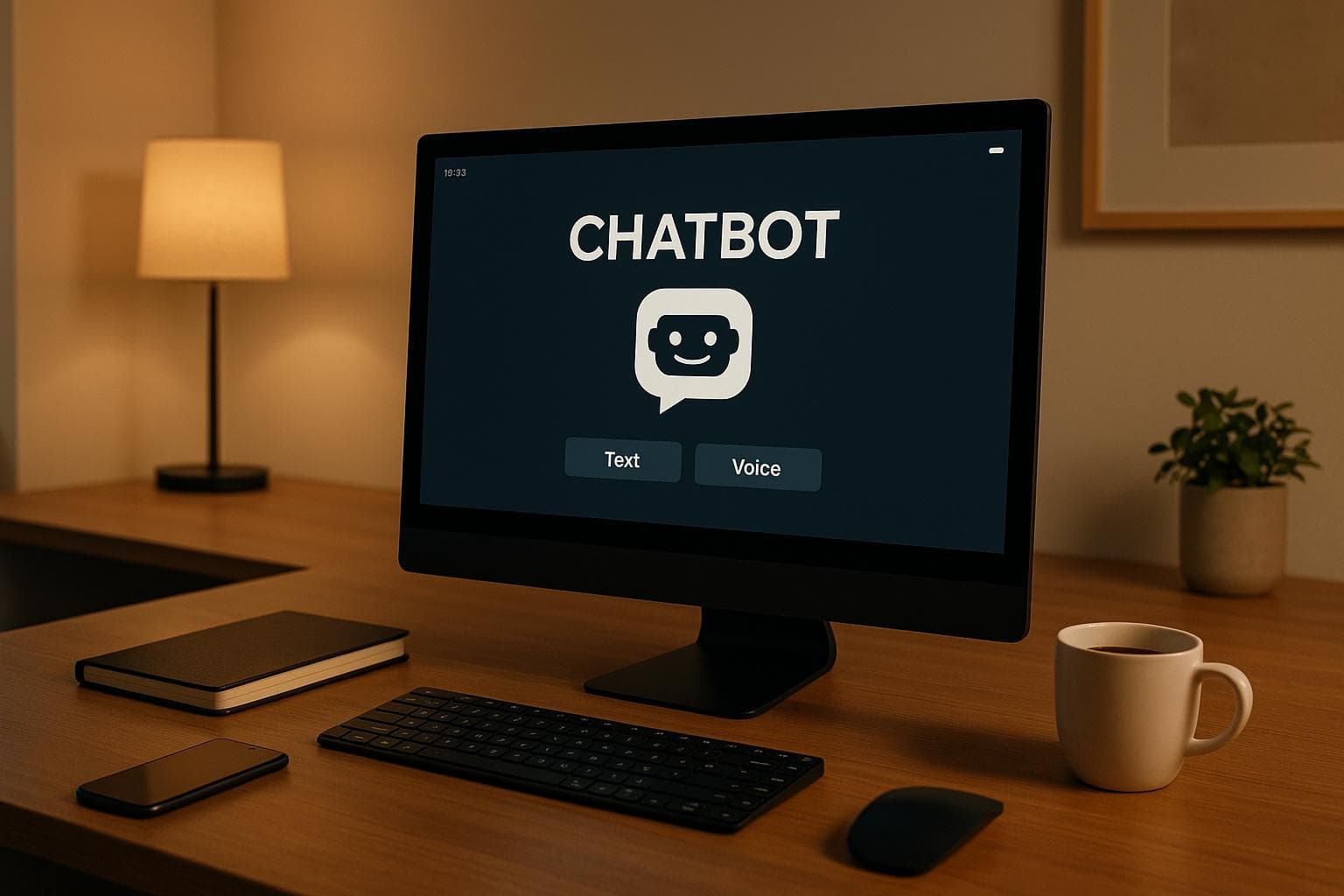
Best poly ai chatbot alternative
Poly AI is a leading voice assistant platform, but it may not meet every business's needs, especially smaller ones or those focused on text-based solutions. Here are four alternatives to consider in 2025:
- OpenAssistantGPT: A budget-friendly, no-code platform ideal for text-based interactions. It integrates with popular website builders and offers a free plan.
- Kore.ai: Designed for enterprises, it provides advanced automation tools and supports over 30 channels. Pricing is custom-quoted.
- Synthflow AI: Focuses on voice automation with a drag-and-drop interface. Best for businesses handling large call volumes.
- Vapi AI: Developer-friendly with support for 100+ languages and competitive pricing. Built for high-demand environments.
Quick Comparison
| Platform | Focus | Starting Price | Key Strengths | Limitations |
|---|---|---|---|---|
| OpenAssistantGPT | Text-based chatbots | Free | No-code, open-source, integrations | No voice capabilities |
| Kore.ai | Enterprise AI | $50/month | Advanced features, omnichannel | Complex setup, unclear pricing |
| Synthflow AI | Voice automation | $29/month | Easy-to-use, voice-first | Limited languages, low ratings |
| Vapi AI | Voice AI for devs | $0.05/minute | 100+ languages, developer tools | Requires technical expertise |
Each platform caters to different needs. OpenAssistantGPT is great for small businesses, Kore.ai suits enterprises, Synthflow excels in voice automation, and Vapi AI is a strong choice for developers.
Top 3 Apps like Poly AI: Poly AI Alternatives
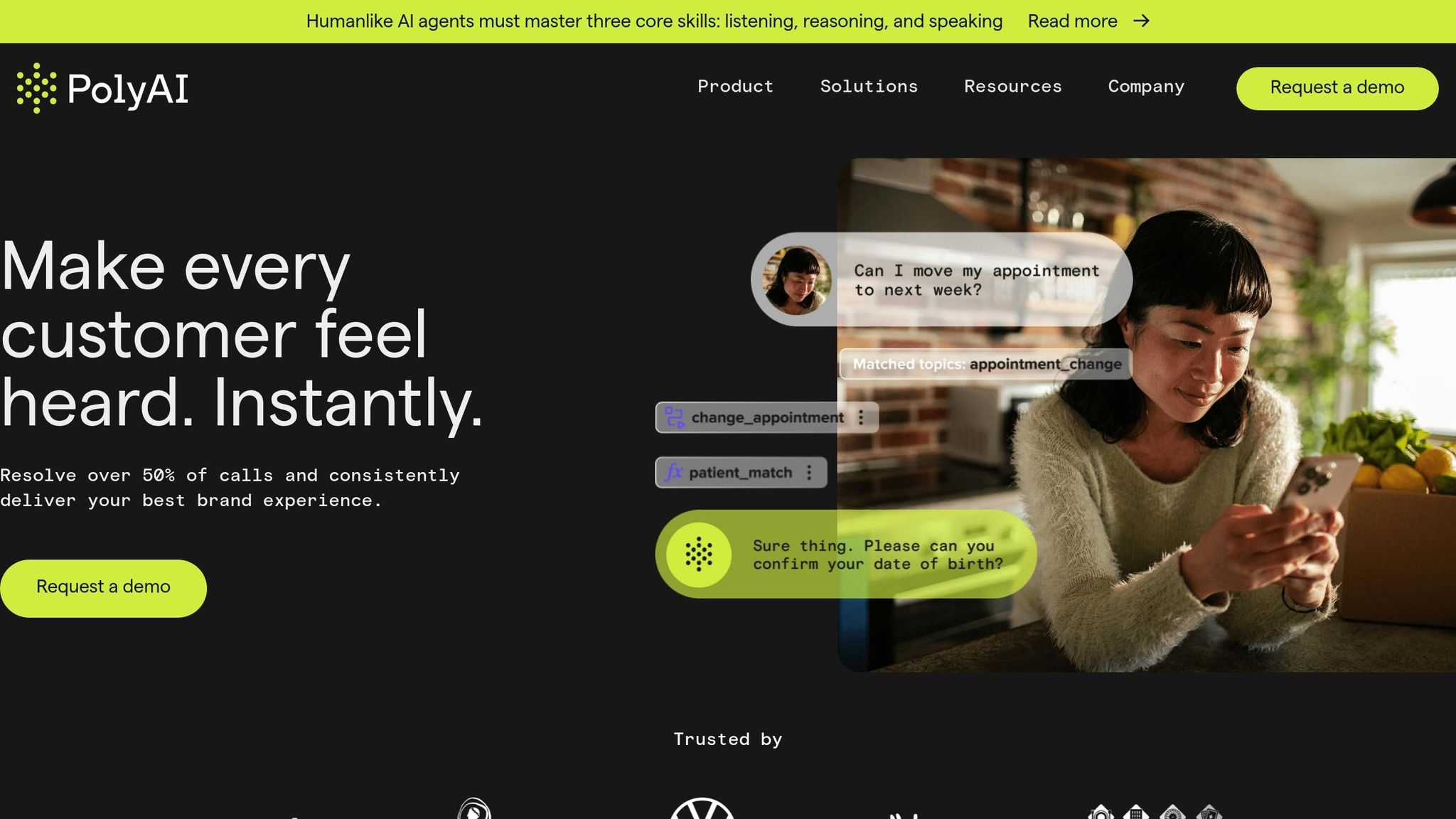
1. OpenAssistantGPT
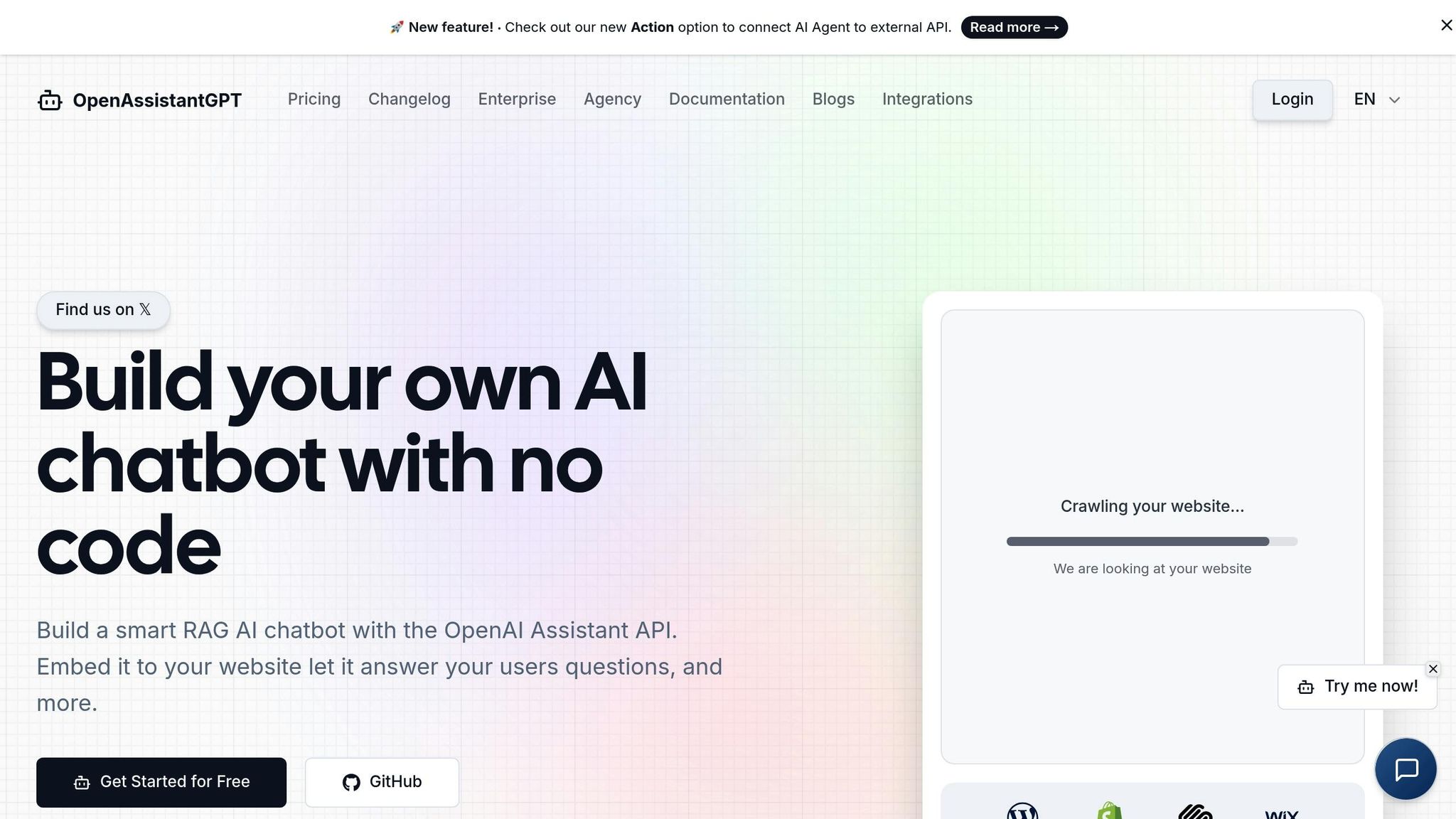
OpenAssistantGPT is a no-code platform that simplifies the process of creating AI chatbots using OpenAI's Assistant API. Designed for text-based interactions, it’s easy to deploy and has already drawn over 4,000 users aiming to streamline communication. This reflects the growing demand for straightforward, no-code AI tools.
The platform’s open-source code, hosted on GitHub, has earned 379 stars as of 2024 and is regularly updated. This transparency allows businesses to review and, if needed, modify the code to suit their specific needs.
Features
OpenAssistantGPT offers a robust set of tools compatible with GPT-4, GPT-3.5, and GPT-4o models, giving users the flexibility to choose the AI model that best fits their requirements. Key features include:
- Web Crawling: Automatically extracts content from websites.
- File Analysis: Supports multiple formats like CSV, XML, and images.
- AI Agent Actions: Enables the chatbot to dynamically query API endpoints.
- Web Search: Provides access to real-time information.
- Secure Communication: Supports SAML/SSO authentication for creating private chatbots accessible only to authorized users.
- Lead Collection: Converts customer queries into sales opportunities.
These tools make OpenAssistantGPT a versatile choice for businesses looking to automate customer interactions and streamline operations.
Integration Capabilities
The platform integrates effortlessly with popular website builders like WordPress, Shopify, Squarespace, and Wix. Businesses can embed chatbots directly on their websites using a simple HTML snippet or the NextJS SDK for quick deployment. This enables real-time customer support with minimal setup.
Such integrations allow businesses to quickly transition from installation to benefiting from the platform, backed by a clear and straightforward pricing model.
Pricing
OpenAssistantGPT offers flexible pricing plans to cater to different business needs:
- Free Plan: Best for personal projects or testing, includes 1 chatbot, 1 crawler, 3 files, 1 action, and 500 messages per month.
- Basic Plan ($18/month): Ideal for small businesses, it provides 9 chatbots, 9 crawlers, 27 files, 9 actions, unlimited messages, and lead collection features.
- Pro Plan ($54/month): Designed for larger operations, it includes 27 chatbots, 27 crawlers, 81 files, 27 actions, 5 custom domains, and whitelabeling to remove "Powered by OpenAssistantGPT" branding.
- Enterprise Plan: Custom pricing tailored for large organizations and agencies.
These pricing options ensure businesses of all sizes can find a plan that aligns with their goals.
Use Cases
OpenAssistantGPT is a powerful tool for website owners using platforms like WordPress, Shopify, Squarespace, or Wix to boost customer engagement. For e-commerce businesses, chatbots can handle tasks like answering product questions, providing order updates, and delivering basic support - all of which reduce the burden on customer service teams. Additionally, the platform’s lead collection and secure communication features make it a valuable asset for service-based businesses and internal corporate use cases.
2. Kore.ai
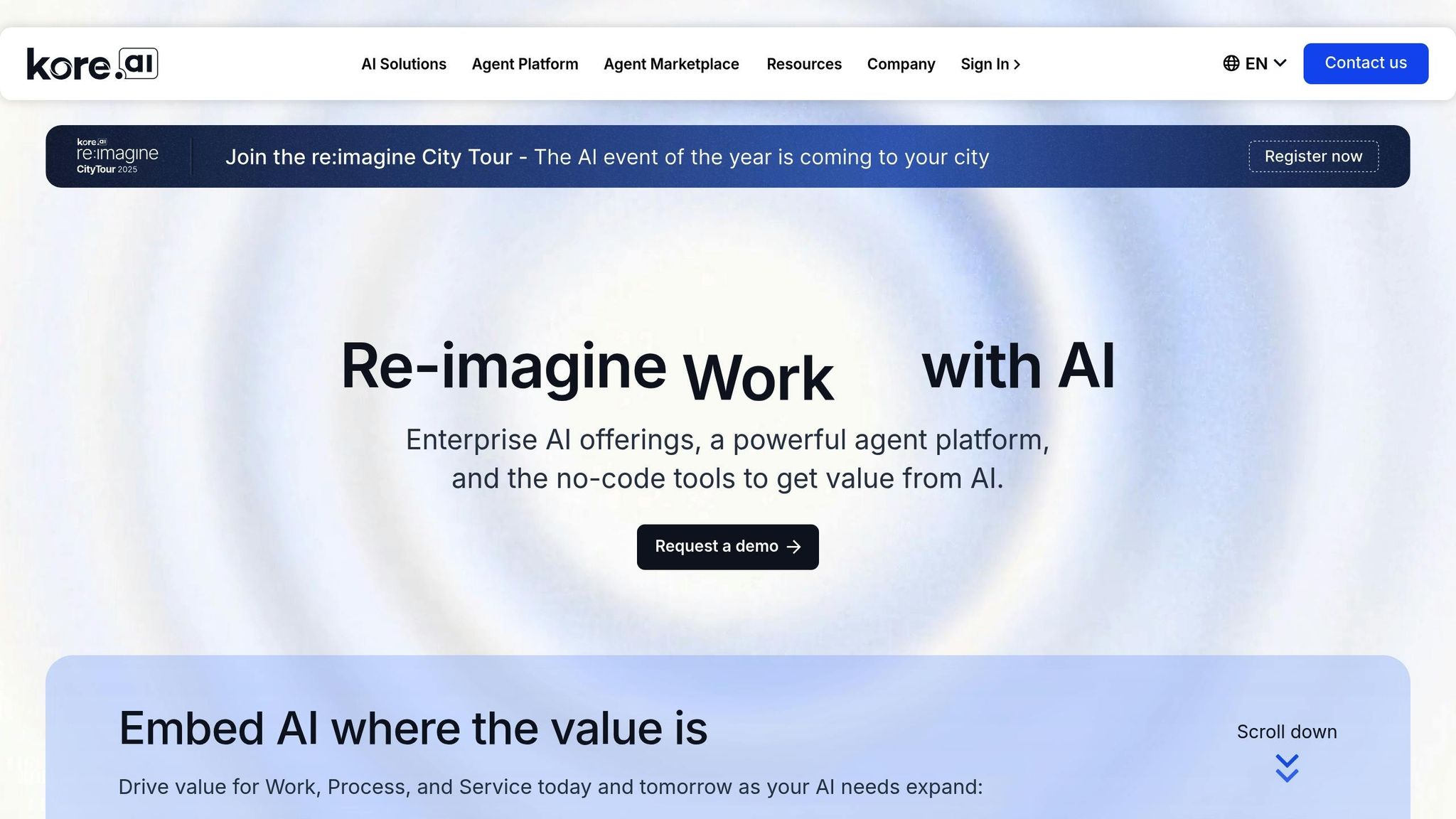
Kore.ai is a no-code platform designed to support over 400 enterprises by leveraging AI to improve work processes, customer service, and operational efficiency. Its standout feature is the XO Platform, which uses a proprietary multi-layered NLP approach and works seamlessly across more than 30 channels. Kore.ai automates repetitive tasks throughout organizations and is compatible with any language model, data source, or cloud setup. Let’s dive into what makes Kore.ai's tools effective.
Features
Kore.ai offers tailored solutions to meet diverse business needs:
- AI for Work: Provides pre-built agents with options for no-code customization.
- AI for Service: Improves customer service using conversational AI agents and smooth human-assisted transitions.
- AI for Process: Streamlines knowledge-heavy tasks through custom AI agents.
The XO Platform includes a user-friendly GUI-based dialog builder and a Search AI tool that consolidates data from multiple sources. This allows for conversational searches enhanced by Retrieval Augmented Generation, delivering personalized answers. With over 250 pre-designed agent and tool templates, Kore.ai also offers no-code tools like an agentic app builder, integration studio, and conversation designer. These features integrate effortlessly with enterprise systems, ensuring smooth functionality.
Integration Capabilities
Kore.ai connects with key enterprise systems like Salesforce, SAP, Epic, SharePoint, Slack, and Google Drive. Its Integration Framework supports universal connectivity through advanced API management and visual data mapping. For those needing further customization, API hooks and SDKs are available.
Pricing
Kore.ai's pricing starts at around $300,000 per year, with additional options for voice bot usage and advanced analytics. For more accessible automation solutions, Kore.ai offers three pricing tiers under its Automation AI package:
- Essential: $50/month (annual commitment required)
- Advanced: $150/month (annual commitment required)
- Enterprise: Custom pricing tailored to specific needs
For Standard and Enterprise plans, detailed pricing requires direct consultation with the sales team.
Use Cases
Kore.ai is best suited for large enterprises in industries like financial services, healthcare, and retail. With its ability to handle complex system integrations and support omnichannel customer service across web, mobile, voice, and messaging platforms, Kore.ai is a strong option for organizations with extensive IT resources and sophisticated operational needs.
3. Synthflow AI
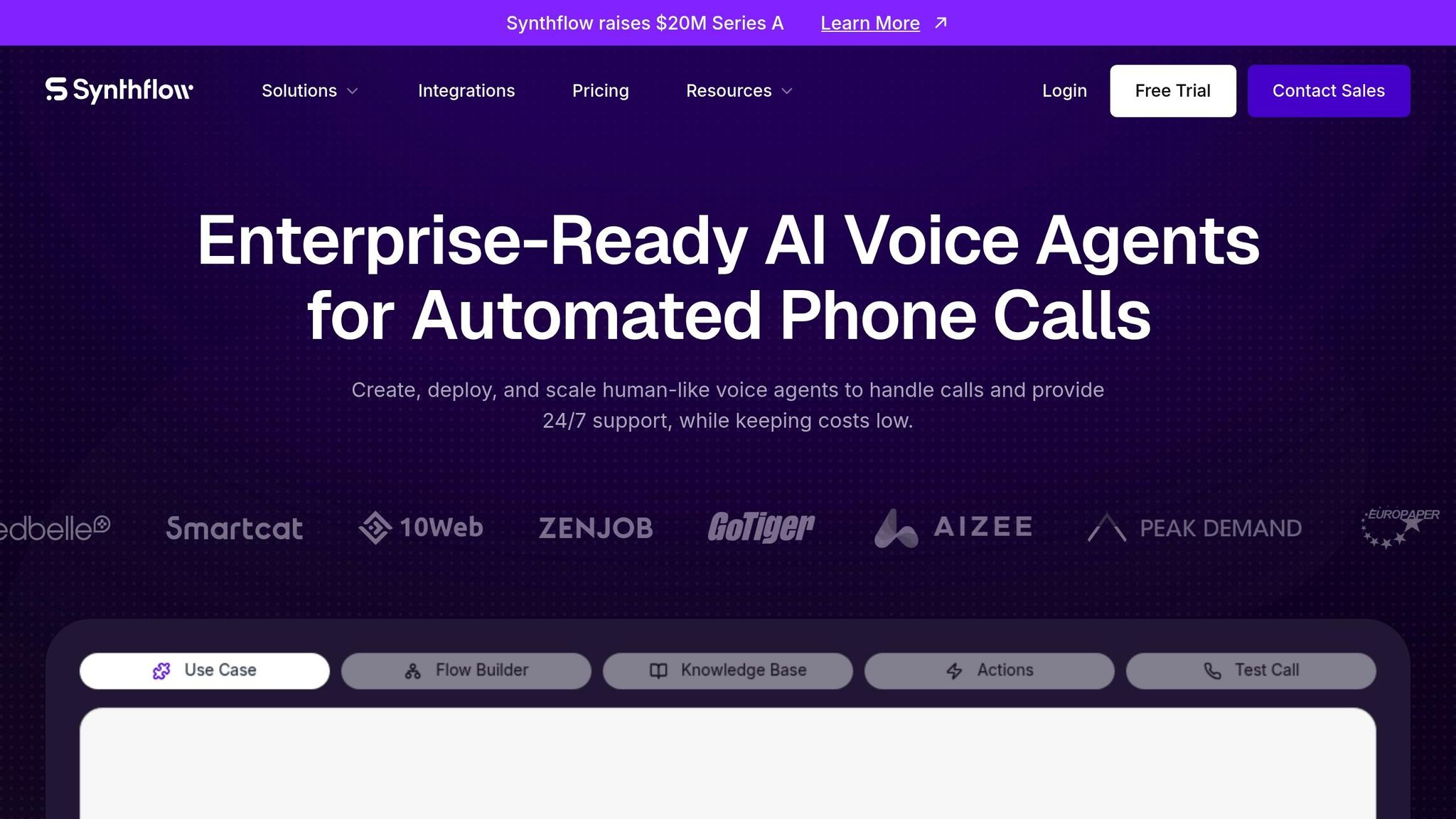
Synthflow AI is a no-code platform tailored for deploying voice AI agents to automate phone calls. Unlike traditional chatbot platforms that focus on text-based interactions, Synthflow AI has developed an AI Voice Operating System designed to sound convincingly human. With over 10 million voice calls handled every month across 30+ countries, it has established itself as a leader in voice automation.
Features
Synthflow AI’s voice-first approach revolves around a drag-and-drop interface, allowing users to create custom call flows without any coding. This system can handle tasks like real-time booking, sending SMS follow-ups, detecting voicemails, and transferring calls seamlessly.
Key highlights include support for over 15 languages, 99.9% uptime reliability, and a 35% increase in answered calls. The platform has also saved businesses more than 4 million hours of work. For agencies, there’s a white-label option for customized branding. Plus, Synthflow AI adheres to SOC2, HIPAA, and GDPR standards, making it a trusted choice for industries like healthcare and finance.
Integration Capabilities
Synthflow AI integrates with over 200 tools, including major CRMs, calendars, and telephony systems. Its enterprise-grade APIs and pre-built integrations make connecting seamless. Some notable integrations include:
- Twilio for telephony management
- HubSpot for CRM functionality
- Zapier for workflow automation
- ElevenLabs for voice customization
- Cal.com for appointment scheduling
- Stripe for payment processing
- OpenAI for enhanced AI features
For businesses with unique needs, custom integrations and telephony connections are available upon request.
Pricing
Synthflow AI offers flexible pricing plans to accommodate businesses of all sizes:
- Starter: $29/month (50 minutes, 5 concurrent calls)
- Pro: $375/month annually or $450 monthly (2,000 minutes, 25 concurrent calls)
- Growth: $750/month annually or $900 monthly (4,000 minutes, 50 concurrent calls)
- Agency: $1,250/month annually or $1,400 monthly (6,000 minutes, 80 concurrent calls)
- Enterprise: Custom pricing, starting at $0.08 per minute for high-volume users
Overages cost between $0.12 and $0.13 per minute. Additional features, like new phone numbers ($1.50/month) and enhanced queuing ($500/month), are available for further customization. A 14-day free trial is included with the Pro, Growth, and Agency plans.
Use Cases
Synthflow AI is ideal for businesses handling large volumes of phone operations. Here are some standout examples:
- Medbelle used Synthflow’s AI assistant for appointment management, achieving a 60% improvement in scheduling efficiency and 2.5x more booked appointments.
-
Smartcat streamlined its lead qualification process, cutting booking costs by 70%. They also increased the number of contacts dialed by 31% and answered calls by 24%. Daniel Lefanov, Implementation Manager at Smartcat, shared:
"Synthflow's Voice AI Agents help us book more demos faster. We increased the conversion rates in the top of our lead pipeline: the number of contacts dialed by 31% and the number of answered calls, 24%. With more people dialed, we re-focused the sales team on high-value signals."
- A $230 million multinational BPO operator deployed over 40 branded voice agents within 60 days, automating 600,000 calls monthly without increasing staff.
- A leading U.S.-based CRM platform implemented Synthflow AI to manage over 500,000 calls per month, eliminating the need for additional engineering resources.
Industries with frequent phone interactions - like healthcare, real estate, customer service, and lead generation - benefit greatly from Synthflow AI. For example, Peak Demand replaced outdated forms with Synthflow Voice AI for a transit provider, enabling residents to make quick calls while the AI handled requests instantly.
sbb-itb-7a6b5a0
4. Vapi AI
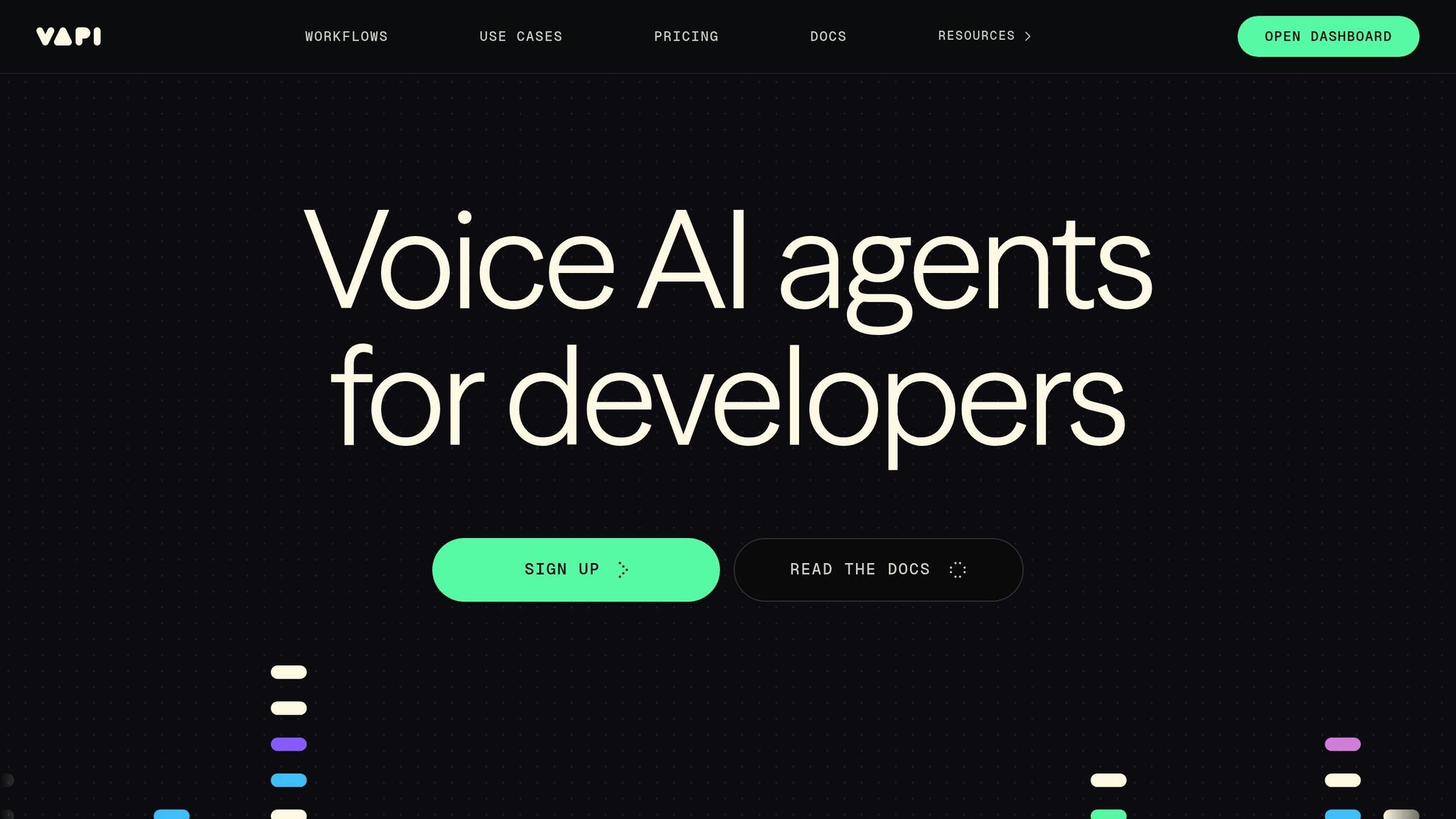
Vapi AI is a voice AI platform designed with developers in mind, trusted by over 225,000 developers and handling 400,000 calls every day. With an impressive 99.9% uptime and the ability to manage more than 1 million concurrent calls, it’s built to support enterprise-level demands. Let’s dive into its features, integrations, pricing, and practical applications.
Features
Vapi AI offers a no-code interface that supports more than 100 languages, ensuring smooth, fast responses with optimized latency. It includes advanced features like interruption handling and customizable audio-text fusion models. The platform also integrates Orchestration Models for enhanced interactions, incorporating tools like emotion detection, background noise filtering, and backchanneling to differentiate between filler words and meaningful acknowledgments.
For developers, the Blocks feature provides a visual workflow builder, while Squads enables collaborative management of multiple assistants. Additionally, users can import files to create a Knowledge Base, improving the accuracy of responses.
To ensure reliability, Vapi AI includes built-in guardrails to prevent errors and protect sensitive data. Automated testing identifies risks, and users can bring their own models for transcription, language processing, or text-to-speech services.
Integration Capabilities
Vapi AI is built with integration in mind, offering API-native access and compatibility with over 40 apps via client/server SDKs and webhooks. It seamlessly integrates with tools like Make, allowing users to automate workflows effortlessly. GHL workflows and Make scenarios can also be imported directly into the platform.
The platform’s voice assistants can trigger app integrations, performing tasks like scheduling meetings or updating CRM systems through voice commands. It supports telephony systems, websites, and mobile apps, all secured with robust authentication methods.
"A key technical requirement was the ability to bring our own stack - Vapi's developer-friendly API-first approach made this possible."
Pricing
Vapi AI uses a consumption-based pricing model, starting at $0.05 per minute for calls. Additional costs include $2 per month for phone numbers, with transcription, models, voice, and telephony services charged separately. Pricing options include:
- Ad-Hoc Infra (Pay as you go): 3,000 bundled call minutes, $0.18 per minute for overages, and $0.05 per minute for call hosting (includes a $10 credit).
- Agency Plan: $500/month.
- Startup Plan: $1,000/month.
- Enterprise Plan: Custom pricing.
For compliance with HIPAA, DPA, or PCI standards, there’s an additional charge of $1,000 per month. New users also receive a $10 credit to get started.
Use Cases
With its powerful features and seamless integrations, Vapi AI is well-suited for high-demand environments. Its ability to handle over 1 million simultaneous calls and support multiple languages makes it a great fit for industries like healthcare, customer service, and sales. For example, FleetWorks successfully integrated Vapi AI into their existing tech stack, leveraging its developer-friendly API.
"A key technical requirement was the ability to bring our own stack - Vapi's developer-friendly API-first approach made this possible."
The platform’s Squads feature enables multi-assistant collaboration, while real-time data processing ensures efficient performance. Voice assistants powered by Vapi AI can manage tasks like customer service, appointment scheduling, lead qualification, and data collection, all while maintaining high-quality interactions through emotion detection and noise filtering. With SOC2, HIPAA, and PCI compliance, it also meets the strict regulatory requirements for handling sensitive data.
Platform Comparison
When it comes to selecting the right platform, the decision often boils down to a balance of features, pricing, and how well it integrates with your existing systems. Each platform has its own strengths and drawbacks, making them suitable for different needs.
OpenAssistantGPT
This platform is the most budget-friendly option, offering transparent pricing and delivering impressive results. Users have reported a 35% drop in support tickets and a 60% boost in resolution times. Its open-source design is a developer's dream, while the no-code interface ensures accessibility for non-technical users. However, it primarily focuses on text-based interactions, leaving voice capabilities off the table.
Kore.ai
Kore.ai shines in enterprise environments, earning high marks for usability, features, design, and support. It boasts a powerful AI agent platform and advanced automation tools. That said, its pricing remains unclear, which could be a hurdle for smaller businesses looking for cost transparency.
Synthflow AI
Synthflow AI offers a straightforward pricing structure, starting at $29/month, along with predictable costs for phone coverage in the U.S., Canada, and Australia at $1.50/month. It’s tailored for businesses with its focus on integrations and phone support. However, it falls short with 1.0/5 ratings across all categories, which raises concerns about user satisfaction.
Vapi AI
Vapi AI delivers exceptional conversational quality in over 100 languages. Its usage-based pricing model is affordable, with calls costing $0.07 per minute and no monthly fees. Despite its technical strengths, it struggles with a 1.0/5 overall rating, and its support also scores poorly at 1.0/5.
For businesses comparing costs, Synthflow’s cheapest plan averages $0.58 per minute, while Vapi offers a more competitive $0.07 per minute without monthly fees. OpenAssistantGPT, on the other hand, provides an enticing free tier with 500 messages per month.
| Platform | Pros | Cons |
|---|---|---|
| OpenAssistantGPT | Free tier available, reduces support tickets by 35%, open-source, no-code interface, transparent pricing | Limited to text-based interactions, smaller ecosystem due to being a newer platform |
| Kore.ai | Perfect 5.0/5 user ratings, enterprise-grade features, strong automation tools | Unclear pricing, potentially too complex for small businesses |
| Synthflow AI | Predictable fixed pricing, broader phone coverage, business-focused integrations | Limited to 7 languages, poor 1.0/5 user ratings, lacks technical flexibility |
| Vapi AI | Supports 100+ languages, high-quality conversations, competitive per-minute pricing | Low 1.0/5 user ratings, complicated pricing structure, requires technical expertise |
Key Differences to Consider
Language support is a major differentiator. Vapi leads the pack with support for over 100 languages, while Synthflow is limited to just seven.
Integration capabilities also play a crucial role. OpenAssistantGPT excels in embedding text-based interactions on platforms like WordPress, Shopify, Squarespace, and Wix. Meanwhile, Synthflow focuses on business-friendly integrations, and Vapi prioritizes technical flexibility and compatibility with various AI models.
Ultimately, the right choice depends on your operational goals and the features that matter most to your business.
Conclusion
Choosing the right AI chatbot platform boils down to understanding your business needs, technical requirements, and budget. Each platform caters to different audiences, offering distinct strengths and considerations.
For small to medium-sized businesses and startups in the US, OpenAssistantGPT stands out. Its transparent pricing, starting with a free plan that includes 500 messages per month, combined with a no-code interface and open-source foundation, has proven benefits - like reducing support tickets by 35% and saving $25,000 annually. Its seamless integration with platforms like WordPress, Shopify, and Squarespace makes it a practical choice for smaller operations.
For enterprises with more advanced needs, Kore.ai offers robust automation tools tailored for larger-scale operations. However, its custom-quoted pricing may not suit smaller organizations.
Synthflow AI appeals to teams focused on voice automation, thanks to its usage-based pricing model. Yet, businesses should carefully evaluate its features and long-term reliability to ensure it meets their specific needs. Similarly, Vapi AI, with its developer-friendly voice AI APIs and competitive pricing, is worth considering. That said, assessing its customer support and overall dependability is crucial for making an informed decision.
In today’s competitive AI chatbot market, platforms that combine powerful functionality, simplicity, and transparent pricing are the most appealing. OpenAssistantGPT’s open-source design, proven impact on business operations, and ease of use make it a strong contender for US businesses aiming to integrate AI-driven solutions in the years ahead. Balancing capability with accessibility remains key in selecting the right platform.
FAQs
What should I look for in a poly AI chatbot alternative for my business?
When choosing a poly AI chatbot alternative, it's crucial to prioritize features that match your business requirements. Look for options with customization capabilities, smooth integration with your current systems, multilingual support, scalability to grow with your needs, and a pricing structure that fits your budget. Also, consider the platform's user experience, security measures, and how effectively it aligns with your business objectives.
One option worth considering is OpenAssistantGPT. This platform stands out with its no-code chatbot builder, making it easy to create and deploy bots without technical expertise. It integrates effortlessly with platforms like WordPress and Shopify, and it offers advanced tools such as web search functionality and file attachment analysis. With its combination of flexibility, affordability, and robust features, it’s a solid choice for businesses looking to enhance both efficiency and customer engagement.
What makes OpenAssistantGPT a better choice for chatbot integration compared to other platforms?
OpenAssistantGPT sets itself apart with its easy integration options and customization features. Whether you want to embed chatbots directly into your website, streamline workflows, or connect with platforms like WordPress, Shopify, and Wix, the process is straightforward. Thanks to its open-source design, it provides the flexibility to meet a wide range of business requirements.
While some platforms struggle with issues like slow implementation or limited functionality, OpenAssistantGPT delivers a budget-friendly and intuitive solution. With its no-code setup, it supports advanced functionalities such as API queries, file analysis, and multilingual capabilities. This makes it a smart choice for businesses aiming to improve customer interactions while keeping operational expenses in check.
What makes OpenAssistantGPT the ideal chatbot solution for small and medium-sized businesses?
OpenAssistantGPT: Tailored for Small and Medium Businesses
OpenAssistantGPT is built specifically for small and medium-sized businesses, offering simple, no-code tools that make customization a breeze. Whether you want to embed chatbots on your website or connect them with your existing APIs, the platform lets you do it all without needing any technical skills.
What’s more, OpenAssistantGPT adapts to your growth with scalable plans. This means you can streamline customer support, cut down on response times, and improve satisfaction - all while keeping costs in check. Its affordable pricing, flexibility, and intuitive design make it an excellent choice for businesses aiming to elevate customer interactions without the hassle or high costs of enterprise-level solutions.